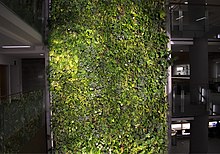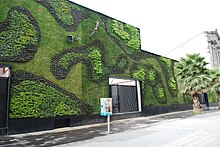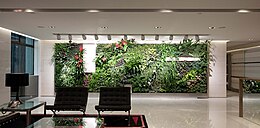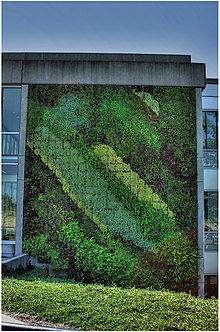How Can I Plant Succulent in a Wall Fountain

Particular of Patrick Blanc's exterior green wall of the Musée du Quai Branly (image 2012)

A light-green wall is a vertical built structure intentionally covered past vegetation.[1] [2] Green walls include a vertically practical growth medium such as soil, substitute substrate, or hydroculture felt; likewise as an integrated hydration and fertigation delivery system.[1] They are likewise referred to as living walls or vertical gardens, and widely associated with the commitment of many beneficial ecosystem services.[i] [3]
Green walls differ from the more established vertical greening typology of 'green facades' as they have the growth medium supported on the vertical face up of the host wall (as described beneath), while green facades have the growth medium only at the base (either in a container or as a ground bed). Green facades typically back up climbing plants that climb up the vertical face of the host wall, while greenish walls can arrange a variety of plant species.[3] Green walls may exist implanted indoors or outdoors; as freestanding installations or fastened to existing host walls; and applied in a diverseness of sizes.
Stanley Hart White, a Professor of Mural Architecture at the University of Illinois from 1922 to 1959, patented a 'vegetation-Bearing Architectonic Structure and System' in 1938, though his invention did non progress across prototypes in his backyard in Urbana, Illinois.[4] [v] The popularising of light-green walls is frequently credited to Patrick Blanc, a French botanist specialised in tropical woods undergrowth. He worked with builder Adrien Fainsilber and engineer Peter Rice to implement the first successful large indoor dark-green wall or Mur Vegetal in 1986 at the Cité des Sciences et de l'Industrie in Paris, and has since been involved with the blueprint and implementation of a number of notable installations (e.g. Musée du quai Branly, collaborating with architect Jean Nouvel[half-dozen] [7]).
Dark-green walls have seen a surge in popularity in recent times.[three] An online database provided by greenroof.com for example had reported 80% of the 61 large-scale outdoor light-green walls listed as constructed afterwards 2009, with 93% after 2007.[eight] Many notable light-green walls take been installed at institutional buildings and public places, with both outdoor and indoor installations gaining significant attention.[nine] As of 2015, the largest greenish wall is said to comprehend two,700 square meters (29,063 square feet) and is located at the Los Cabos International Convention Centre designed past Mexican architect Fernando Romero.[10]
Media types [edit]


A wall of living plants designed by Patrick Blanc at Caixa Forum near Atocha station, Madrid

Green walls are often synthetic of modular panels that hold a growing medium and can be categorized according to the type of growth media used: loose media, mat media, and structural media.
Media Costless [edit]

Media Free tillandsia light-green wall designed by Lloyd Godman, East Melbourne, Australia.

Media Free tillandsia green wall structural cross section. Designed by Lloyd Godman, East Melbourne, Australia.
Media Free systems apply a method of selecting institute species which are best suited to the climate where the green wall is located, and as a upshot, these media free systems do not require soil substrates, fertilizers, or reticulated watering systems. These Media Free systems result in green walls which are considerably lighter than other methods, and too require significantly less maintenance, while the adventure of liquid migration into adjoining structural walls is eliminated. The constitute species which can be used in Media Free systems varies depending on the location of the planned dark-green wall. Xeric plants, such as Tillandsias, tin exist used considering they absorb bachelor atmospheric water and nutrients via trichome leaf cells, and their roots accept developed to concord onto a back up structure, unlike other plants which employ their roots as a medium to absorb nutrients. The other benefit of Tillandsias inside a Media Complimentary system is that these plants use a crassulacean acid metabolism to photosynthesize, and they have evolved to withstand long periods of oestrus and drought, and as a effect, these plants abound slowly and require minimal maintenance. These Media Free greenish walls ofttimes use a structural steel frame that is infilled with wire mesh, which is and then attached to the façade of the structure, and plants are individually attached to this wire mesh. These frames are beginning from the supporting structure to permit airflow betwixt the green wall and the supporting structure, and this offset results in additional cooling to the adjoining building. Every three-to-5-years, any boosted plant growth can be harvested to reduce weight, and these plant pups can be utilized for additional dark-green walls. As long equally suitable species are matched to the climate of the dark-green wall's location, then potential plant losses beyond whatever 3-to-5-year menstruum is pocket-sized.
Freestanding media [edit]
Freestanding media are portable living walls that are flexible for interior landscaping. Zauben living walls are designed with hydroponic technology that conserves 75% more water than plants grown in soil, self-irrigates, and includes moisture sensors.
Loose media [edit]
Loose medium walls tend to be "soil-on-a-shelf" or "soil-in-a-bag" type systems. Loose medium systems take their soil packed into a shelf or bag and are then installed onto the wall. These systems require their media to be replaced at least once a twelvemonth on exteriors and approximately every two years on interiors.[ commendation needed ] Loose soil systems are non well suited for areas with whatever seismic activity. Virtually chiefly, because these systems can easily accept their medium blown away by wind-driven rain or heavy winds, these should not be used in applications over 2.5 m loftier. There are some systems in Asia that have solved the loose media erosion problem by use of shielding systems to hold the media inside the green wall arrangement fifty-fifty when soil liquefaction occurs nether seismic load. In these systems, the plants tin even so upwards-root themselves in the liquified soil under seismic load, and therefore it is required that the plants exist secured to the system to forestall them from falling from the wall. Loose-soil systems without physical media erosion systems are best suited for the home gardener where occasional replanting is desired from season to season or year to year. Loose-soil systems with physical media erosion systems are well suited for all light-green wall applications.
Mat media [edit]
Mat type systems tend to be either coir fiber or felt mats. Mat media are quite thin, fifty-fifty in multiple layers, and as such cannot back up vibrant root systems of mature plants for more than three to five years before the roots overtake the mat and h2o is not able to adequately wick through the mats. The method of reparation of these systems is to replace large sections of the organisation at a time by cutting the mat out of the wall and replacing it with new mat. This procedure compromises the root structures of the neighboring plants on the wall and oft kills many surrounding plants in the reparation process. These systems are all-time used on the interior of a building and are a skilful choice in areas with low seismic activeness and small plants that volition not abound to a weight that could rip the mat apart under their own weight over time. It is important to note that mat systems are particularly water inefficient and ofttimes crave abiding irrigation due to the thin nature of the medium and its inability to concord water and provide a buffer for the plant roots. This inefficiency oftentimes requires that these systems accept a water re-circulation system put into place at an additional cost. Mat media are ameliorate suited for small-scale installations no more eight feet in height where repairs are hands completed.
Sheet media [edit]
Semi-open jail cell polyurethane sheet media utilising an egg crate pattern has successfully been used in recent years for both outdoor roof gardens and vertical walls. The water holding capacity of these engineered polyurethanes vastly exceeds that of coir and felt based systems. Polyurethanes practise not biodegrade, and hence stay viable equally an active substrate for 20+ years. Vertical wall systems utilising polyurethane sheeting typically employ a sandwich construction where a water proof membrane is applied to the back, the polyurethane sheeting (typically two sheets with irrigation lines in between) is laid and and then a mesh or anchor braces/bars secure the assembly to the wall. Pockets are cut into the face of the kickoff urethane sheet into which plants are inserted. Soil is typically removed from the roots of any plants prior to insertion into the urethane mattress substrate. A flaked or chopped noodle version of the same polyurethane material tin can also be added to existing structural media mixes to boost water retention.
Structural media [edit]


Structural media are growth medium "blocks" that are non loose, nor mats, merely which incorporate the best features of both into a block that tin be manufactured into various sizes, shapes and thicknesses. These media have the reward that they practice not break down for x to 15 years, tin can be fabricated to have a higher or lower water holding capacity depending on the plant selection for the wall, can take their pH and EC's customized to arrange the plants, and are easily handled for maintenance and replacement.[ citation needed ]
There is also some give-and-take involving "active" living walls. An active living wall actively pulls or forces air through the plants le quality to the indicate that the installation of other air quality filtration systems can be removed to provide a cost-savings. Therefore, the added cost of design, planning and implementation of an active living wall is however in question. With further research and UL standards to support the air quality data from the living wall, edifice code may one day allow for our buildings to take their air filtered by plants.[11]
The expanse of air quality and plants is continuing to be researched. Early studies in this area include NASA studies performed in the 1970s and 1980s by B. C. Wolverton.[12] In that location was also a written report performed at the Academy of Guelph by Alan Darlington.[13] Other enquiry has shown the effect the plants take on the health of office workers.[fourteen]
Role [edit]

An indoor greenish wall in an role in Hong Kong
Green walls are found most often in urban environments where the plants reduce overall temperatures of the building. "The primary cause of estrus build-up in cities is insolation, the absorption of solar radiations past roads and buildings in the city and the storage of this heat in the building material and its subsequent re-radiation. Establish surfaces however, every bit a event of transpiration, do non rise more than than iv–v °C above the ambient and are sometimes cooler."[15]
Living walls may likewise be a means for water reuse. The plants may purify slightly polluted water (such as greywater) past absorbing the dissolved nutrients. Bacteria mineralize the organic components to brand them available to the plants. A report is underway at the Bertschi School in Seattle, Washington, using a GSky Pro Wall system, all the same, no publicly available data on this is available at this time.
Living walls are specially suitable for cities, every bit they allow expert utilise of available vertical surface areas. They are also suitable in arid areas, as the circulating water on a vertical wall is less likely to evaporate than in horizontal gardens.
The living wall could also function for urban agronomics, urban gardening, or for its beauty as art. It is sometimes congenital indoors to aid alleviate sick building syndrome.

Living walls are as well best-selling for remediation of poor air quality, both to internal and external areas.
Light-green walls provide an additional layer of insulation that tin can protect buildings from heavy rainwater which leads to direction of heavy storm water and provides thermal mass. They besides help reduce the temperature of a building because vegetation absorbs large amounts of solar radiation. This tin reduce energy demands and cleanse the air from VOC'due south (Volatile Organic Compounds) released past paints, article of furniture, and adhesives. Off-gassing from VOCs can cause headaches, eye irritation, and airway irritation and internal air pollution. Green walls can also purify the air from mould growth in building interiors that can cause asthma and allergies. Vegetation in green walls can help with the mitigation of the heat island effect and contribute to urban biodiversity.[two]
Indoor dark-green walls can have a therapeutic upshot from exposure to vegetation. The artful feel and visual appearance of green walls are other examples of the benefits - but besides affects the indoor climate with reduced CO2 level, noise level and air pollution abatement.[16] [3] However, to have the optimal effect on the indoor climate it is important that the plants in the light-green wall has the best weather for growth, both when talking about watering, fertilizing and the right amount of light. To take the best result on all of the aforementioned, some green wall systems has special and patented technologies that is developed to the benefit of the plants.[17]
Some other example in urban areas is green walls provide audio-visual protection and reduces the dissonance through audio absorption.
Thomas Pugh, a biogeochemist at the Karlsruhe Found of Technology in Germany, created a computer model of a green wall with a broad selection of vegetation. The study showed results of the light-green wall arresting nitrogen dioxide and particulate matter. In street canyons where polluted air is trapped, greenish walls can absorb the polluted air and purify the streets.
Green facades compared to living walls [edit]

Scaffold modular green wall
Green facades are plants that climb or hang forth the walls. Plants tin can grow upwardly or down. There are 2 classifications to greenish facades: direct and indirect. Directly green facades are attached to the wall while indirect dark-green facades incorporates a structure that will support it for plants. Indirect green facades include two different solutions: continuous and modular. Modular and continuous systems secure the living wall and further protect and then it can concur itself from the irresolute weather. Modular green facades have vessels for rooting plants and come up in forms such as trays, vessels, planter tiles, or flexible bags.
Living walls have a uniform fashion of growing plants. At that place is more than technology and installation involved. They have permeable screens where each plant is individually put in and in the application is lightweight.
Plants [edit]

Green wall the Simon Fraser University, Burnaby, British Columbia, Canada.
Regular maintenance, the right places, and the right plants are needed to sustain a living wall. Pruning dead plants and weeds will continue the wall healthy, and gaps need to be filled. Plants demand to exist shut together in order to meliorate aesthetics. The right plants demand to be chosen for the right places because the ones with illness can contaminate others surrounding it. In club to accept a wall growing all year round, 95 percentage of the plants need to be evergreen. Perennials are all-time for seasonal green walls. It is necessary to choose plants that tin can withstand disease since replacement is plush. The lifespans of plants will too need to be considered when assessing long term dark-green walls. There are specific plants best suited for unlike environments. Different plants for shade, sun, wind, or a combination of them will need to be considered for longer lifespans.
List of herbs best suited for dark-green facades [edit]
- Basil
- Bay laurel
- Caraway
- Chamomile
- Chives
- Coriander
- Curry constitute
- Dill
- Lavender
- Lemon balm
- Lemongrass
- Marjoram
- Mint
- Oregano
- Parsley
- Rosemary
- Sage
- Sorrel
- Tarragon
- Thyme
Edible plants best suited for greenish facades [edit]
- Chard
- Reddish tomatoes
- Dwarf cabbages
- Lettuce
- Radishes
- Rocket
- Silverbeet
- Minor chili peppers
- Spinach
- Strawberries
- Watercress
Plants for dominicus [edit]
- Achillea
- Acorus
- Armeria maritima
- Bergenia
- Bidens
- Calamintha nepeta
- Carex
- Convolvulus cneorum
- Erica
- Geranium
- Lavander
- Liriope
- Pansy
- Rosemary
- Sedum
- Solidago
- Thyme
- Westringia
Plants for shade [edit]
- Adiantum
- Asplenium
- Begonia
- Bergenia
- Chlorophytum comosum
- Erica
- Euphorbia
- Heuchera
- Polystichum
- Snowdrop
Sources [edit]
- Clapp, Fifty., & Klotz, H. (2018). Vertical gardens. London ; Sydney ; Auckland: New Holland.
- Coronado, South. (2015). Grow a living wall - create vertical gardens with purpose: Pollinators - he. Cool Springs Press.
- Hyatt, B. (2017, June 29). The ins and outs of green wall installation and maintenance. Retrieved March 2, 2019, from https://www.totallandscapecare.com/landscaping/green-wall-maintenance/
- Manso, Maria; Castro-Gomes, João (January 2015). "Green wall systems: A review of their characteristics". Renewable and Sustainable Free energy Reviews. 41: 863–871. doi:10.1016/j.rser.2014.07.203.
- Gunawardena, K., & Steemers, G. (2019). Living walls in indoor environments. Building and Surround, 148 (January 2019), 478–487. Living walls in indoor environments
- Pictures: Greenish Walls May Cut Pollution in Cities. (2016, May 17). Retrieved from https://news.nationalgeographic.com/news/2013/03/pictures/130325-greenish-walls-surround-cities-science-pollution/
- Reggev, Yard. (2018, January xviii). Living Green Walls 101: Their Benefits and How They're Fabricated. Retrieved March 2, 2019, from https://world wide web.dwell.com/article/living-green-walls-101-their-benefits-and-how-theyre-fabricated-350955f3
- Gunawardena, Yard.R.; Wells, Yard.J.; Kershaw, T. (2017). "Utilising green and bluespace to mitigate urban heat island intensity". Science of the Total Environment. Elsevier BV. 584–585: 1040–1055. Bibcode:2017ScTEn.584.1040G. doi:10.1016/j.scitotenv.2017.01.158. ISSN 0048-9697. PMID 28161043.
Tree-dominated greenspace offers greater heat stress relief when most required. Badly designed bluespace may exacerbate heat-stress during oppressive conditions.
- Thomas A. M. Pugh; A. Robert MacKenzie; J. Duncan Whyatt; C. Nicholas Hewitt (2012). "The effectiveness of green infrastructure for improvement of air quality in urban street canyons" (PDF). Environmental Science & Engineering science. 46 (14): 7692–7699. Bibcode:2012EnST...46.7692P. doi:x.1021/es300826w. PMID 22663154.
- Visone, M. (2019). Down to the Vertical Gardens. Compasses, 32, 33-forty. Downwardly to the Vertical Gardens
Run into also [edit]
- Edifice-integrated agriculture
- Folkewall
- Dark-green roof
- The Hanging Gardens of Babylon
- Hügelkultur
- Vertical farming
References [edit]
- ^ a b c Medl, Alexandra; Stangl, Rosemarie; Florineth, Florin (2017-eleven-15). "Vertical greening systems – A review on recent technologies and enquiry advancement". Building and Surroundings. 125: 227–239. doi:10.1016/j.buildenv.2017.08.054. ISSN 0360-1323.
- ^ a b Gunawardena, K. R.; Wells, M. J.; Kershaw, T. (2017-04-xv). "Utilising green and bluespace to mitigate urban heat isle intensity". Scientific discipline of the Total Surround. 584–585: 1040–1055. Bibcode:2017ScTEn.584.1040G. doi:10.1016/j.scitotenv.2017.01.158. ISSN 0048-9697. PMID 28161043.
- ^ a b c d Gunawardena, Kanchane; Steemers, Koen (2019-01-fifteen). "Living walls in indoor environments". Edifice and Surround. 148: 478–487. doi:10.1016/j.buildenv.2018.11.014. ISSN 0360-1323.
- ^ Hindle, Richard L. "Reconstructing the 'Vegetation-Bearing Architectonic Structure and System (1938)'". Graham Foundation. Archived from the original on January 25, 2013. Retrieved February 20, 2013.
- ^ Hindle, Richard L. (June 2012). "A vertical garden: origins of the Vegetation-Bearing Architectonic Structure and System (1938)". Studies in the History of Gardens & Designed Landscapes. 32 (2): 99–110. doi:10.1080/14601176.2011.653535. S2CID 56350350. Archived from the original on 2019-06-26. Retrieved 2019-06-26 .
- ^ "Vertical gardens a light-green solution for urban setting". The Times of India. Feb 14, 2013. Archived from the original on May half dozen, 2013. Retrieved Feb twenty, 2013.
- ^ "Welcome to Vertical Garden Patrick Blanc – Vertical Garden Patrick Blanc". www.verticalgardenpatrickblanc.com. Archived from the original on 2017-01-06. Retrieved 2017-01-06 .
- ^ "The International Greenroof & Greenwall Projects Database!". greenroofs.com. Greenroofs.com, LLC. Archived from the original on 18 October 2013. Retrieved 17 October 2013.
select 'green wall' as blazon and 'living wall' under 'greenroof type'
- ^ "Upwards trend". www.airport-earth.com. Airport World. Archived from the original on 31 July 2016. Retrieved 29 March 2013.
An increasing number of airports are investing in vertical gardens and living walls to create a unique setting
- ^ For largest wall as of 2012, come across Eric Martin; Nacha Cattan (Jun twenty, 2012). "Calderon Fetes G-20 every bit Sun Sets on Mexico Ruling Party". bloomberg.com. Bloomberg LP. Archived from the original on 16 April 2015. Retrieved 17 October 2013.
- For size of wall, come across "Los Cabos International Convention Center (ICC)". greenroofs.com. Greenroofs.com, LLC. Archived from the original on 3 March 2016. Retrieved 17 October 2013.
- ^ "Purdue Solar Decathlon". www.purdue.edu. Archived from the original on 2017-10-xviii. Retrieved 2017-06-26 .
- ^ "Wolverton Environmental Services". www.wolvertonenvironmental.com. Archived from the original on 2008-03-10.
- ^ Darlington, A; Chan, M; Malloch, D; Pilger, C; Dixon, MA (March 2000). "The biofiltration of indoor air: implications for air quality". Indoor Air. ten (one): 39–46. doi:x.1034/j.1600-0668.2000.010001039.x. PMID 10842459.
- ^ Fjeld, Tove; Veiersted, Bo; Sandvik, Leiv; Riise, Geir; Levy, Finn (1998). "The Upshot of Indoor Foliage Plants on Health and Discomfort Symptoms amidst Part Workers". Indoor and Built Environment. vii (4): 204–209. doi:x.1177/1420326x9800700404. S2CID 111319315.
- ^ Ong, Boon Lay (May 2003). "Green plot ratio: an ecological measure for architecture and urban planning". Landscape and Urban Planning. 63 (4): 197–211. doi:10.1016/S0169-2046(02)00191-iii.
- ^ Wolverton, B. C.; Johnson, Anne; Bounds, Keith (fifteen September 1989). "Interior Landscape Plants for Indoor Air Pollution Abatement" (PDF).
- ^ "Living green walls from Natural Greenwalls for offices and professionals".
External links [edit]
- Dark-green Infrastructure Resources Guide
Source: https://en.wikipedia.org/wiki/Green_wall
0 Response to "How Can I Plant Succulent in a Wall Fountain"
Publicar un comentario